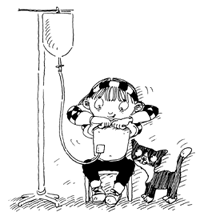 Peritoneal dialysis (PD) uses the peritoneum as the semi-permeable membrane for dialysing the blood. A catheter is used for peritoneal access. (Illustration by Jan Smith from a leaflet produced by the Nottingham Childrens Renal Unit). Solutes pass from the blood into the dialysate along their concentration gradient, and water by an osmotic gradient created by adding glucose or a polymer to the dialysate. Watch an animation
Peritoneal dialysis (PD) uses the peritoneum as the semi-permeable membrane for dialysing the blood. A catheter is used for peritoneal access. (Illustration by Jan Smith from a leaflet produced by the Nottingham Childrens Renal Unit). Solutes pass from the blood into the dialysate along their concentration gradient, and water by an osmotic gradient created by adding glucose or a polymer to the dialysate. Watch an animation
Continuous ambulatory peritoneal dialysis (CAPD) typically involves 4 two-litre fluid exchanges daily, with fluid left in constantly. They are usually 4-6 hours apart with a longer gap overnight. Each bag change takes 30-40 minutes. Automated peritoneal dialysis (APD) occurs for 8-9 hours overnight whilst the patient sleeps.
The peritoneal dialysis catheter (Tenckhoff catheter) is usually placed under general anaesthetic. After an interval the patient begins training to undertake dialysis at home. Laparoscopy can be used. Local anaesthetic insertion is possible.
Techniques for assessing the adequacy of peritoneal dialysis are controversial. Survival appears to be most strongly correlated with residual native renal function, which is better preserved in patients on peritoneal dialysis than with haemodialysis. It is difficult to provide adequate dialysis by PD for some adults with little or no residual renal function. Properties of the peritoneal membrane differ between patients, and over time in individual patients. Episodes of peritoneal infection and responses to dialysate may damage the membrane. This may lead to deterioration of control of biochemistry and fluid balance, and over a long period many patients who start treatment on peritoneal dialysis transfer to haemodialysis.
Peritoneal dialysis may be preferred to haemodialysis in the following circumstances:
- Children
- Adults who value greater independence and freedom to travel
- Patients with cardiovascular instability or risk factors
Contra-indications:
- Major abdominal surgery or peritoneal adhesions
- Inguinal hernias (unless repaired)
- Severe respiratory compromise
- Inability to perform the technique safely and hygienically
The sick PD patient
For general issues concerning sick dialysis patients (fluid management, potassium, infections etc.) see The sick dialysis patient
Peritonitis is the major complication of PD, usually caused by Staph. epidermidis or bowel organisms. Patients often present with abdominal pain, pyrexia, cloudy PD effluent – but may have only one of these at first. Investigations reveal a raised white cell count in fluid. Treatment is urgent in these circumstances and all units will have a regimen for blind antibiotic therapy after cultures have been sent. Antibiotics are usually added to dialysate and/or given systemically.
Blood glucose testing: Patients using dialysate containing the glucose polymer icodextrin may have high levels of other circulating sugars that lead to misleadingly high values on some commonly used glucose testing kits. This could lead to dangerously inappropriate management and hypoglycaemia.
